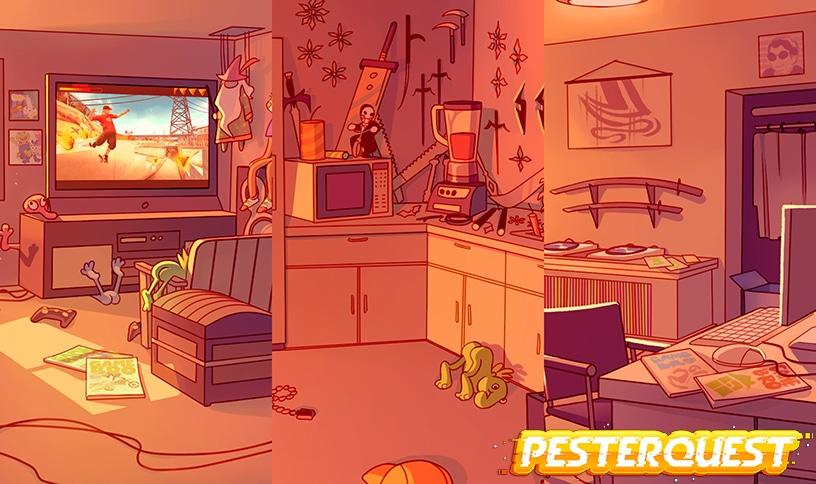PesterQuest is a strange mish-mash of narratives held together by an oddly relatable narrative voice. It’s the latest entry in the Homestuck series of visual novels; PesterQuest acts as a sequel to Hiveswap Friendship Simulator. It was released episodically from September 2019 through to April 2020.
PesterQuest Release Date Trailer:
You play through PesterQuest as the MSPA Reader. I had to Google this one; I won’t lie to you. An MSPA Reader is essentially anyone who reads through Microsoft Paint-based visual novels. This instantly provides PesterQuest’s narratives with an odd realism and relatability. I personally don’t read through visual novels, but I can imagine this is something enjoyed by those who do. It helps make you feel even more a part of the narratives.
The 14 episodes of PesterQuest are split between taking place on Earth and on Alternia. With literally no previous experience in playing anything from the Homestuck Series, I was confused for a while, while playing. But once I looked past the various references and call-backs to the larger narrative, I found I enjoyed the interactions that played out. I played through a couple of the episodes and slowly found myself becoming more familiarised with the madness.
Graphically, PesterQuest’s art-style is rather simplistic.
This is in no way a bad thing, though. The backgrounds weren’t complicated, but I found the color palettes used often helped to reflect the tone the narrative was trying to set. They were thematic to the character in question, too. For example, you meet Rose in the second episode of PesterQuest. She’s a witch, to a degree, and is a writer of magical fiction. For the most part, the backgrounds offer different purples and blues in an effort to reflect this and match the color aesthetic of the character herself.

The parts focusing on the MSPA Reader, mainly at the start of PesterQuest, were the worst artistically. However, this is intentional. The style is reflective of the decade-old MS Paint memes. This is also reflected in the MSPA Reader’s character design. What I did enjoy was the odd reference to this. In comparison to those he meets, the MSPA Reader’s character design is veritably odd. References to this just further the underlying sophistication PesterQuest is written with.

One complaint I do have is the lack of differing panels. As someone who reads graphic novels (but not visual novels), I found myself wanting more visual representation of the words on the screen. I understand that this may just be the difference between the two mediums, though. As I got to enjoy the art-style more, I wanted to see more of it.
The Gameplay of PesterQuest is near-identical to any other game in the genre.
It’s largely just clicking through the bulk of the text and then selecting one of the two-or-three narrative options when they appear. I didn’t expect much else, so I wasn’t disappointed by this. The UI of the game was also easy to navigate and didn’t impose on the rest of the visuals, which was nice.
On the whole, the writing of PesterQuest was well-done as well. I always find second person narration to be a little odd, and PesterQuest was no different. However, I found I got into it fairly quickly. You have to expect this from a visual novel.
What I did feel, at parts, was that the game was written for someone a bit younger than myself. There were some things I simply found uninteresting and bits I found trivial. But this was not all of it. For the most part, I enjoyed it and I found the narrative voice amusing. It’s full of self-reference and dry humour which lands excellently well. It helps make the narrative voice that little bit more relatable, to me anyway, which helped carry my interest throughout my playing of it.

Another thing I didn’t enjoy, however, was the lack of explicit dialogue. Rather than knowing exactly what the narrative voice is saying, it’s muddled in with the internal monologue. This makes some parts of the conversation slightly hard to follow, as the other characters in the conversation react accordingly nonetheless. I don’t know how commonplace this is within visual novels, but I’m personally not a fan of this.
On the whole, PesterQuest is a fun, well-written collection of visual novels.
It offers a good variety through its 14 episodes, with unusual narratives that link back to each other and the larger story in the Homestuck universe. PesterQuest also has a simple-yet-effective art style that does what it’s supposed to do. It helps to reflect the narrative, both visually and tonally.
[penci_review]
Underneath the strange facade of a teleporting, time-traveling mail-man (?), there is a depth to PesterQuest’s narrator and the themes he discusses. He talks about online friendships and loneliness, something which we can all relate to in the current climate. Despite the fact that I strongly suggest you play the other games in the series, or at least one, to help familiarise yourself with what is going on, I had fun while playing.
PesterQuest, an entry in the Homestuck series is available in full on Steam now. Check out the game’s Steam store page for more information. If you missed it, Google Stadia is making Stadia Pro membership free for the next two months. Check out our report here.

